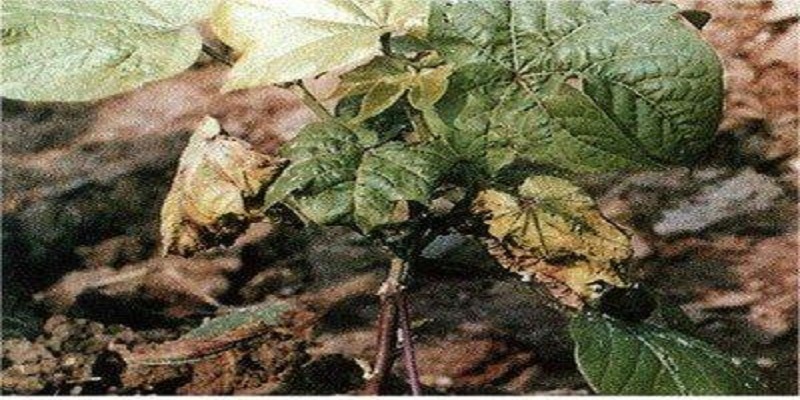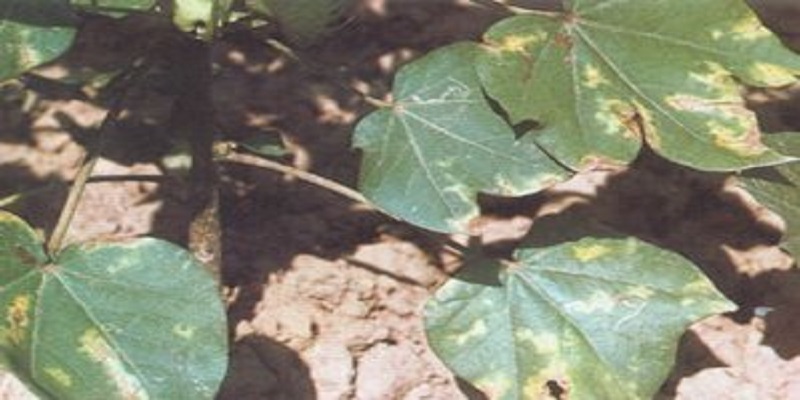一、Fusarium wilt
Symptoms of harm:
Cotton Fusarium wilt can occur from seedlings to adults, with the highest incidence occurring before and after budding. It can be classified into 5 types:
1. Yellow Reticulated Type: The diseased plant’s leaf veins turn yellow, the mesophyll remains green, and some or most of the leaves appear yellow reticulated, gradually shrinking and drying;
2. Yellowing type: Local or large parts of the leaf edges turn yellow, shrink and dry;
3. Purple red type: Local or large parts of the leaves turn purple red, and the veins of the leaves also appear purple red, withering and withering;
4. Green withered type: The leaves suddenly lose water, the color of the leaves becomes slightly dark green, the leaves become soft and thin, the entire plant is green and dry and dies, but the leaves generally do not fall off, and the petioles are bent;
5. Shrinkage type: When there are 5-7 true leaves, most of the top leaves of the diseased plant shrink, deformed, dark green in color, with shortened internodes, shorter than healthy plants, generally not dying, and the xylem of the diseased plant’s root and stem section turns black brown.
Pathogenesis pattern:
The cotton wilt pathogen mainly overwinter in diseased plant seeds, diseased plant residues, soil, and manure. The transportation of contaminated seeds is the main cause of new disease areas, and agricultural operations such as cultivation, management, and irrigation in the affected cotton fields are important factors for close transmission. Pathogenic spores can grow in the roots, stems, leaves, shells, etc. of diseased plants during high humidity, which can spread with airflow and rain, infecting surrounding healthy plants.
The incidence of Cotton Fusarium wilt is closely related to temperature and humidity. Generally, the disease begins at around 20 ℃ soil temperature, and reaches a peak when the soil temperature rises to 25 ℃ -28 ℃; In rainstorm or rainy year in summer, the disease is serious; Cotton fields with low-lying terrain, heavy soil, alkaline soil, poor drainage, nitrogen fertilizer application, and extensive cultivation are severely affected.
Chemical prevention and control:
1. Before sowing, use 40% carbendazim • pentachloronitrobenzene, 50% methyl sulfur • thiram 500 times solution for soil disinfection;
2. At the beginning of the disease, the roots were irrigated with 40% carbendazim • pentachloronitrobenzene, 50% methylsulfide • thiram 600-800 times solution spray or 500 times solution, or 50% thiram 600-800 times solution, 80% mancozeb 800-1000 times solution, with significant control effect;
3. For the heavily diseased fields, at the same time, 0.2% potassium dihydrogen phosphate solution plus 1% urea solution are used for foliar spray every 5-7 days for 2-3 consecutive times. The disease prevention effect is more obvious.
二、Cotton Verticillium Wilt
Symptoms of harm:
Before and after budding in the field, the disease begins to occur, with the edges of the diseased leaves losing water and wilting. Irregular yellow patches appear on the mesophyll between the leaf veins, gradually expanding into green palm like patches on the leaf veins, resembling watermelon skins. The middle and lower leaves gradually develop towards the upper part, without falling or partially falling leaves. The diseased plant is slightly shorter than the healthy plant. After a long drought in summer and rainstorm, or flood irrigation, the leaves suddenly wilted, like scalded by boiling water, and then fell off, which is called acute wilting type.
Chemical prevention and control:
1. Selecting disease-resistant varieties and implementing rotation and crop rotation. In the northern cotton region, using wheat, corn, and cotton rotation can reduce disease incidence; Timely spraying growth regulators such as Sujie An during the bud and boll stages can alleviate the occurrence of verticillium wilt.
2. In the early stage, 80% mancozeb, 50% thiram, 50% methamphetamine, thiram and other agents were sprayed with 600-800 times of liquid once every 5-7 days for three consecutive times, which had a good effect on the prevention of cotton verticillium wilt.
三、The main differences between cotton verticillium wilt and fusarium wilt
1. Verticillium wilt appears late and only begins to occur during the bud stage; Fusarium wilt can cause serious damage during the seedling stage, while the bud stage is the peak stage of the disease.
2. Verticillium wilt mostly starts from the lower leaves, while fusarium wilt often starts from the top down.
3. Verticillium wilt causes yellowing of the mesophyll and fusarium wilt causes yellowing of the veins.
4. Verticillium wilt causes slight dwarfism, while fusarium wilt causes the plant type dwarfed and the internodes shorter;
5. After cutting the stem, the vascular bundle verticillium wilt is light brown, and the fusarium wilt is dark brown.
Post time: Sep-14-2023





